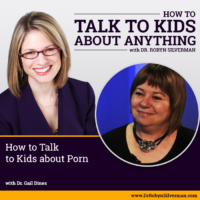Podcast: Play in new window | Download
Subscribe: Apple Podcasts | RSS | More
Flipping the Script! Dr. Robyn Silverman gets interviewed about How to Talk to Kids about Anything

Today, we have the distinct pleasure of welcoming not one but two incredible people to the show. We have the honor to learn from Dr. Robert Melillo and Dr. Robyn Silverman, two renowned experts in their respective fields.
Dr. Melillo, a leading neurologist, and Dr. Silverman, a renowned child development specialist and the author of the best-selling book How to Talk to Kids about Anything, are here to share their wealth of knowledge and insights with us. Together, they bring a unique blend of expertise that spans the realms of neuroscience and child development.
We will now be delving deep into the intersection of these fields; we will uncover practical tips and scripts from these distinguished guests and the book How to Talk to Kids about Anything. Let’s dive into this enlightening conversation with Dr. Robert Melillo and Dr. Robyn Silverman.
I’m so excited today for this special podcast where Dr. Robert Melillo is interviewing me on my new book, How to Talk to Kids about Anything! It’s out now wherever books are sold and I hope you have yours—it’s currently #1 on Amazon in the School-Age Children Parenting Category—and that’s because of all of you. Thank you for your support- and please review it- those 5-Star reviews make a huge difference in the algorithm. So TODAY- I want to introduce Clinician, brain researcher, and Best-selling author, Dr. Melillo is one of the most respected specialists in childhood neurological disorders in American and has been helping children with learning disabilities, autism, ADHD, OCD, dyslexia and more for over 30 years. He’s the author of Disconnected Kids- and we interviewed him here on that very book, along with several others including Reconnected kids- and there’s even a TV show based on that one. We’re flipping the script again so here is my guest interviewer for How to Talk to Kids about Anything, so take it away, Dr. Robert Melillo!
Dr. Melillo’s Bio: Dr. Robert Melillo is one of the world’s most sought after and respected experts in Developmental Functional Neurology, Brain Imbalances, hemispheric integration and the diagnosis and correction of most neurobehavioral disorders and learning disabilities. He is also a successful businessman and entrepreneur and has developed many successful businesses. In 2006, he created Brain Balance Achievement Centers which has approximately 150 centers and has helped tens of thousands of families. He is a prolific author and brain researcher, he has published one major text book titled Neurobehavioral Disorders of Childhood an Evolutionary Perspective. He has coauthored approximately 20 chapters in other texts on various subjects related to Dyslexia, Attention, Frontal Lobe Development etc. and he has also published approximately 50 peer reviewed papers. In addition, Dr. Melillo has also written 5 best-selling books including his best known Disconnected Kids which has been translated into 8 languages.
Dr. Robyn’s Bio: Dr. Robyn Silverman is a Child & Teen Development Specialist with a passion for helping kids develop their strengths and thrive. She has always seen children as assets to be developed rather than deficits to be managed. Known as “The Conversation Doc,” Dr. Robyn is the author of the recently released book, How to Talk to Kids about Anything, (and host of the popular podcast of the same name) which provides parents with scripts and tips to broach the toughest topics with children. She has been writing the worldwide program, Powerful Words Character System, for almost 25 years which gives educators the talking points they need to help children become kind, responsible citizens of the world. Dr. Robyn has appeared on the Today Show, Good Morning America, CBS Early Show and Nightline and has been quoted in the New York Times, Washington Post, CNN and many other publications. She lives with her husband, two kids and fuzzy dog in North Carolina.
Important messages:
- About the book: How to Talk to Kids about Anything, and it’s all on tips, scripts, stories, and steps to make even the toughest conversations easier.
- Parts of the Book: So it’s divided into different tough topics, whether it’s how to talk to kids about big feelings and I did it as chapter one because it is the beginning and what’s going on with the brain and what’s going on in the body, because we have to start there. And when we look at anxious behavior, depressed behavior, if your child is sad or fearful or whatever, we need to start there. How do we talk to them about that? Not that it’s just happening to them, but how do we talk to them about it? And then it goes on to different chapters, whether it’s how to talk to kids about sex or death or friendship issues and bullying, or even money.
- Target Readers: What could I do to make it so that other kids weren’t in the same situation? And that’s not let me fix the kid. That’s let me help the parents, the educators, the coaches, so that they know what to say to help the children who are having a tough time.
- Purpose of the book: People are feeling disconnected and this book is going to help them reconnect again. Just like your book helps to help your help parents and kids reconnect again.
- Number One Problem in Parenting: Changing the subject about puberty, about sex, about porn. These are the hot buttons. I have no idea how to start, I don’t want to talk about this with my kids because it doesn’t feel like a kid.
- These are not topics that you think of when you think of kids, and yet they need to have the information. I want the parent to become the trusted source.
- Feeling your Emotions: Fear is a natural stage of development. They have to go through the fear of the dark, fear of being alone, fear of strangers, fear of imaginary, and monsters. This is part of their development of their brain, and they need to go through that. But again, we may see exaggerated versions of that, or it may happen later than typical. But either way, then how to deal with that fear appropriately, or, or you know, how to be able to do behavioral interventions that can help them so that they can get to the next stage of fear.
- On having tough conversation: When your children say something that will stoke your value so dead on, that’s the moment to say, first of all, thank you so much for telling me, because that’s really brave of you to come up and tell me, especially when you think you’re going to be in trouble. Second, I want you to know that you will never get in trouble for with me, for telling me the truth about something that happened, especially when it’s something that you didn’t even know what was going on.
- Respecting privacy: When kids have a real privacy issue is when we’re sneaking around and trying to kind of like do it on the slide. So any parent out there that, that is in this situation, just be upfront about it and tell your kids it’s about safety and about making sure that they’re making the right choices for themselves.
- Disciplining you kids: In those types of cases where you need your child’s cooperation, then we need to be able to give in the information to the child so that they get on board. We brainstorm with the child so that they get on board.
Notable quotable:
- “I think people need tools as to how do you manage the behaviors one way or the other.”
- “If you want to know your purpose, look at your life, and really look at your failures, look at your challenges, you know, that’s probably where your purpose lies.”
- “Real information from an actual expert, someone who is a mom, somebody who does this for a living.”
- “Start off the conversation, and then you can build on the next layer.”
- “It’s a bunch of little conversations along the way that build on your child’s age and development.”
- “Fear is a natural stage of development. This is part of their development of their brain, and they need to go through that.”
- “Remind yourself that sometimes you need to go through their door in order to bring them through yours.”
- “You do not need to be perfect. You do not need to know all the answers. You do not need to map everything out.”
Resources:
- Facebook: https://www.facebook.com/DrRobynSilverman
- Instagram: https://www.instagram.com/drrobynsilverman/
- Twitter: https://twitter.com/DrRobyn
- Website: https://parenting.drrobynsilverman.com/
You can purchase the book here:
- Bookshop: https://bookshop.org/p/books/how-to-talk-to-kids-about-anything-tips-scripts-stories-and-steps-to-make-even-the-toughest-conversations-easier/18912584?ean=9781728246987
- Amazon: https://www.amazon.com/Talk-Kids-about-Anything-Conversations/dp/1728246989/ref=sr_1_1?crid=2DTRZ13WDMAA0&keywords=how+to+talk+to+kids+about+anything&qid=1696950664&sprefix=how+to+talk+to+kids+abuot%2Caps%2C100&sr=8-1
- Barnes&Noble: https://www.barnesandnoble.com/w/how-to-talk-to-kids-about-anything-robyn-silverman/1142463581?ean=9781728246987
- Books-a-Million: https://www.booksamillion.com/search?filter=&id=8969509417572&query=How+to+Talk+to+Kids+about+Anything








